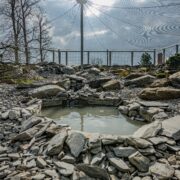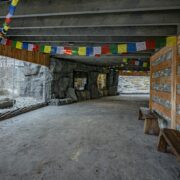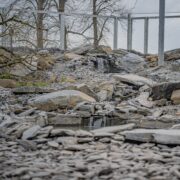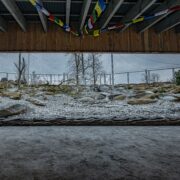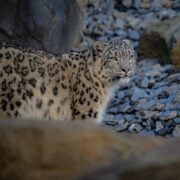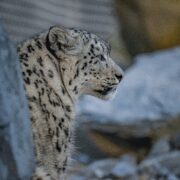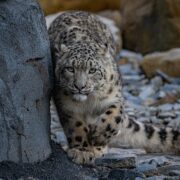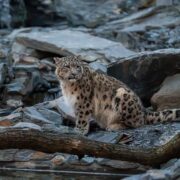Two iconic snow leopards have arrived here at the zoo, ahead of the opening of our new Himalayan habitat
It’s the first time in our 93-year history that our carnivore experts have cared for the highly threatened species.
The immersive habitat – which is now home to male leopard Yashin and female Nubra – has been designed to authentically recreate the rocky terrain of the Himalayan mountains using more than 600 tonnes of scree and rocks, kindly donated by Wienerberger UK – the world’s largest producer of bricks.
The habitat has two large outdoors areas, featuring rocky outcrops, shallow cave retreats, ledges and steep rugged cliffs.
Having overhangs under which the snow leopards can mark their scent is key to recreating the wild experience. In their native home, upper surfaces are often covered with snow and using the underside of a ledge helps to preserve the scent message for much longer.
Air-cooled caves will take visitors nose-to-nose with the snow leopards while providing shelter and a cool place for the big cats when the weather is warm outside. The cooler temperatures in these caves are designed to replicate the climate of their high, mountainous habitat.
Having arrived from zoos in Europe after being carefully matched up as part of an important conservation breeding programme, the pair have ‘hit it off’ straight away and are hopeful that they’ll go on to have cubs in the future.
“The arrival of snow leopards is a huge milestone in our zoo’s long history and signifies our commitment to protecting another of the world’s most threatened big cat species.”
Mike Jordan, Director of Animals and Plants
Mike continued to say:
“Yashin and Nubra are both just over 18 months old, so they’re incredibly playful, inquisitive and full of energy. They’re also both now at the age where they’d naturally start to leave their mother and become independent, which is why they’ve been paired up here at Chester Zoo as part of a European conservation breeding programme, which is working to safeguard the species from becoming extinct.
“Now that they’ve had some time to settle in and explore their new home here in Chester, the pair appear to have really hit it off and, in time, we’re hopeful that they’ll go on to have cubs together.
“This incredible new habitat not only offers visitors spectacular viewing opportunities and a fascinating glimpse into the harsh, yet beautiful world that snow leopards inhabit. It’ll also help conservationists here to learn more about the lives of these iconic cats, helping to further support global conservation efforts for the species.”
Snow leopards are elusive animals which have adapted to high-altitude living in the Himalayas and Central Asia where they face a number of threats, including climate change which is eroding the landscape they thrive in, habitat loss, poaching and retaliatory killings following cases of human-wildlife conflict.
Sightings have become so rare that they’ve been nicknamed the ‘ghost of the mountains’ by communities that live alongside them.
Mayukh Chatterjee, Regional Field Programme Manager for Asia at the zoo, added:
“Not only have we created a fantastic new home for Yashin and Nubra here at Chester, we’re also joining forces with fellow conservation charity, the Snow Leopard Trust, to contribute to vital efforts to conserve snow leopards and safeguard communities that live alongside them, to foster coexistence.
“The keeping of goats, chickens, sheep and cows is a major source of income for local communities living in Kyrgyzstan. Snow leopards can sometimes wander into communities in search of prey and kill farmers’ livestock, which often results in retaliatory persecution of the big cats. By working alongside these communities, we hope to safely build up their resilience to snow leopards while also helping them generate income through a range of other sustainable livelihood initiatives which are also ‘snow leopard friendly’. We’ve seen huge success with this in other areas of the world with communities in Bolivia that live alongside Andean bears, and villagers in India that live in close proximity to Asian elephants, and we’re confident we can similarly improve the co-existence between people and these highly threatened cats.
“We’re hopeful that these efforts in Kyrgyzstan, in conjunction with our conservation breeding efforts here at the zoo, will play a positive role in creating a future where snow leopards not only survive, but go on to thrive.”
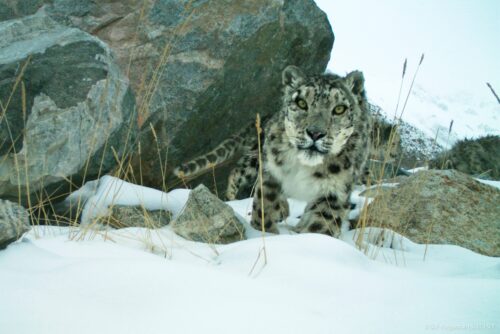
OUR NEW SNOW LEOPARD HABITAT WILL OPEN TO THE PUBLIC ON MONDAY 25 MARCH.
Entry is free, with normal zoo admission. By booking online today you will get the best value, saving you up to 15% off our gate prices.
